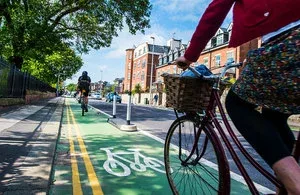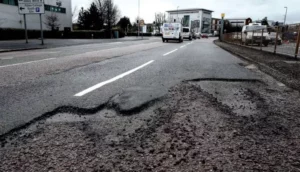The government has reaffirmed its commitment to aim for 50% of all journeys in towns and cities to be walked or cycled by 2030 as well as deliver a world-class cycling and walking network in England by 2040.
This forms part of the second cycling and walking investment strategy (CWIS2) launched this week.
This strategy aligns with the Spending Reviews 2020 and 2021, covering the period from April 2021 to March 2025. We have set a number of objectives over that period to measure progress towards our longer-term ambition for 2040.
The objectives, aims and target in CWIS1, alongside the vision set out in Gear change (2020), have informed the government’s revised set of four objectives to 2025[footnote 2] to:
- increase the percentage of short journeys in towns and cities[footnote 3] that are walked or cycled from 41% in 2018 to 2019 to 46% in 2025
- increase walking[footnote 4] activity, where walking activity is measured as the total number of walking stages[footnote 5] per person per year, to 365 stages per person per year in 2025
- double cycling, where cycling activity is measured as the estimated total number of cycling stages made each year, from 0.8 billion stages in 2013 to 1.6 billion stages in 2025
- increase the percentage of children aged 5 to 10 who usually walk to school from 49% in 2014 to 55% in 2025
These objectives reflect the government’s ambitions to boost overall levels of walking, wheeling and cycling across England while undertaking targeted investment to enable more walking, wheeling and cycling in our towns and cities, said the government.
The objective for walking is more ambitious than the 300 stages per person per year set in CWIS1 and reflects the generally higher overall levels of walking that we have seen in recent years other than during the coronavirus (COVID-19) pandemic.
Continuation of a long-term investment approach to deliver high-quality infrastructure will be supported through:
- the development and delivery of Local cycling and walking infrastructure plans (LCWIPs)
- adherence to Cycle infrastructure design guidance (LTN 1/20)
- the revised Manual for Streets (due to be published later in 2022)
CWIS1 supported a transformation from a short- to long-term approach to planning active travel infrastructure by, for the first time, outlining the financial resources available to local authorities for active travel over a 5-year period.
This has enabled local authorities to take a long-term approach to developing and delivering active travel infrastructure, using a range of funding streams to deliver schemes.
This long-term approach will be supported through ATE as part of a strategic objective to increase local authority capacity and capability around the delivery of active travel infrastructure and behaviour change programmes.
Infrastructure investment and policy development must tackle road safety and personal safety concerns, which may influence levels of walking, wheeling and cycling, in particular for those with certain protected characteristics, such as women, children, disabled people and older people.
As outlined in Gear change, alongside improving safety for people walking and cycling through changes to The Highway Code, the delivery of better cycle infrastructure is the most important thing government can do to enable more people to cycle.
Equally, investment in footway maintenance reduces the incidence of trips and falls, improving lighting gives people more confidence to walk at night and improving crossings can enable people to cross busy streets safely.
In addition to the delivery of high-quality infrastructure, training and behaviour change programmes will help people develop the confidence and skills to walk, wheel and cycle safely.
Total government funding
| Funding source | Projected investment from April 2021 to March 2025 |
|---|---|
| Active travel revenue and capital funds | £1,298 million |
| Wider DfT programmes[footnote 8] | £1,328 million |
| Other central government funding[footnote 9] | £1,158 million |
| Total | £3,784 million |
The (CWIS2) document said: “It is our ambition that walking, wheeling[footnote 1] and cycling are the natural choices for shorter journeys, or as part of a longer journey. Together with our partners, government has been working towards the delivery of this ambition, which was initially set out in the first Cycling and walking investment strategy (CWIS1) in 2017. As required by the Infrastructure Act 2015, this second strategy (CWIS2) sets out objectives and financial resources for the period April 2021 to March 2025.
“Since the first strategy, walking, wheeling and cycling have continued to rise up the government agenda. Increasing active travel will have significant environmental benefits, helping to reduce carbon emissions from transport and improving air quality while reducing congestion and noise pollution on our roads.”
Trudy Harrison, Parliamentary Under Secretary of State with responsibility for active travel, said: “This May, we announced £200 million for new active travel schemes across England, including £35 million for the National Cycle Network and a new £8 million e-cycle programme. We’ve issued 400,000 bike repair vouchers as well as delivering programmes to give everyone the confidence and skills they need to walk, wheel and cycle. Many of our early achievements have been showcased in the 2021 report, Gear change: one year on.
“But we now need to step it up a gear. CWIS2 outlines the total investment into active travel across government through to 2025.
“That means, where possible, redesigning towns, cities and neighbourhoods to enable more active short journeys. It means making active travel more inclusive, by removing barriers that make it harder for some to walk, wheel or cycle to their destinations. And it means using the newly created body, Active Travel England (ATE), to set high standards for active travel infrastructure, new development design, engagement, training and behaviour change.”
The full CWIS2 can be read here: The second cycling and walking investment strategy (CWIS2) – GOV.UK (www.gov.uk)





















